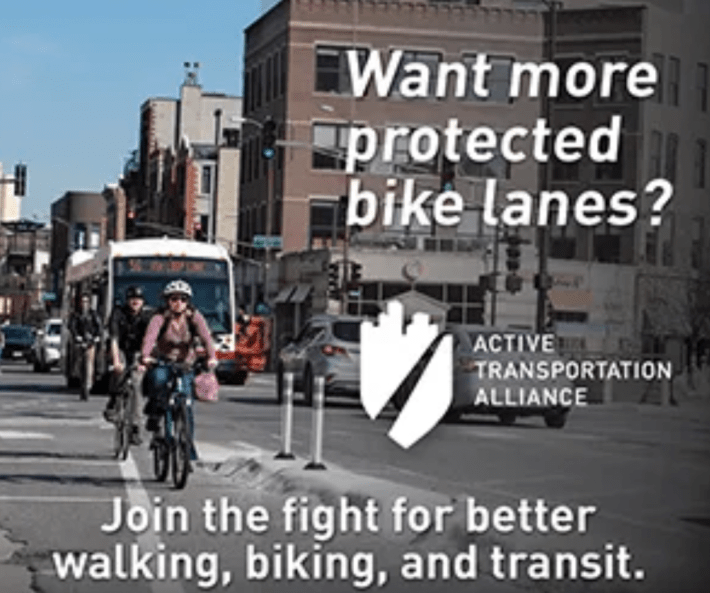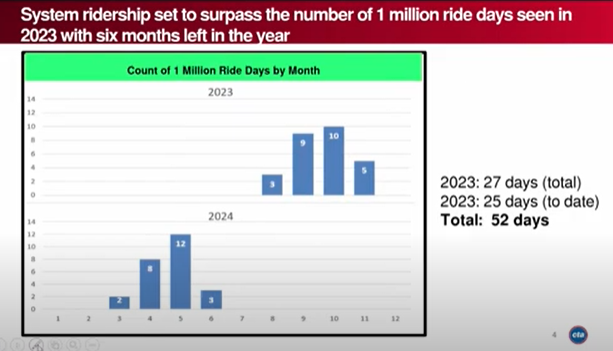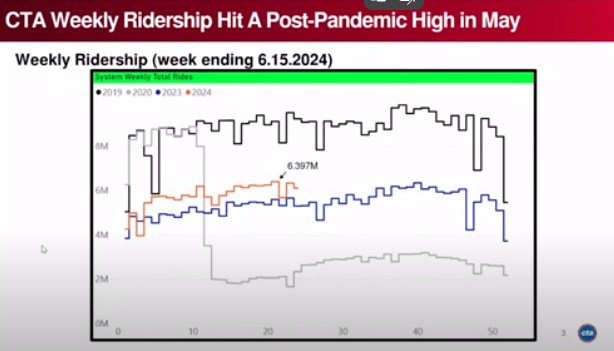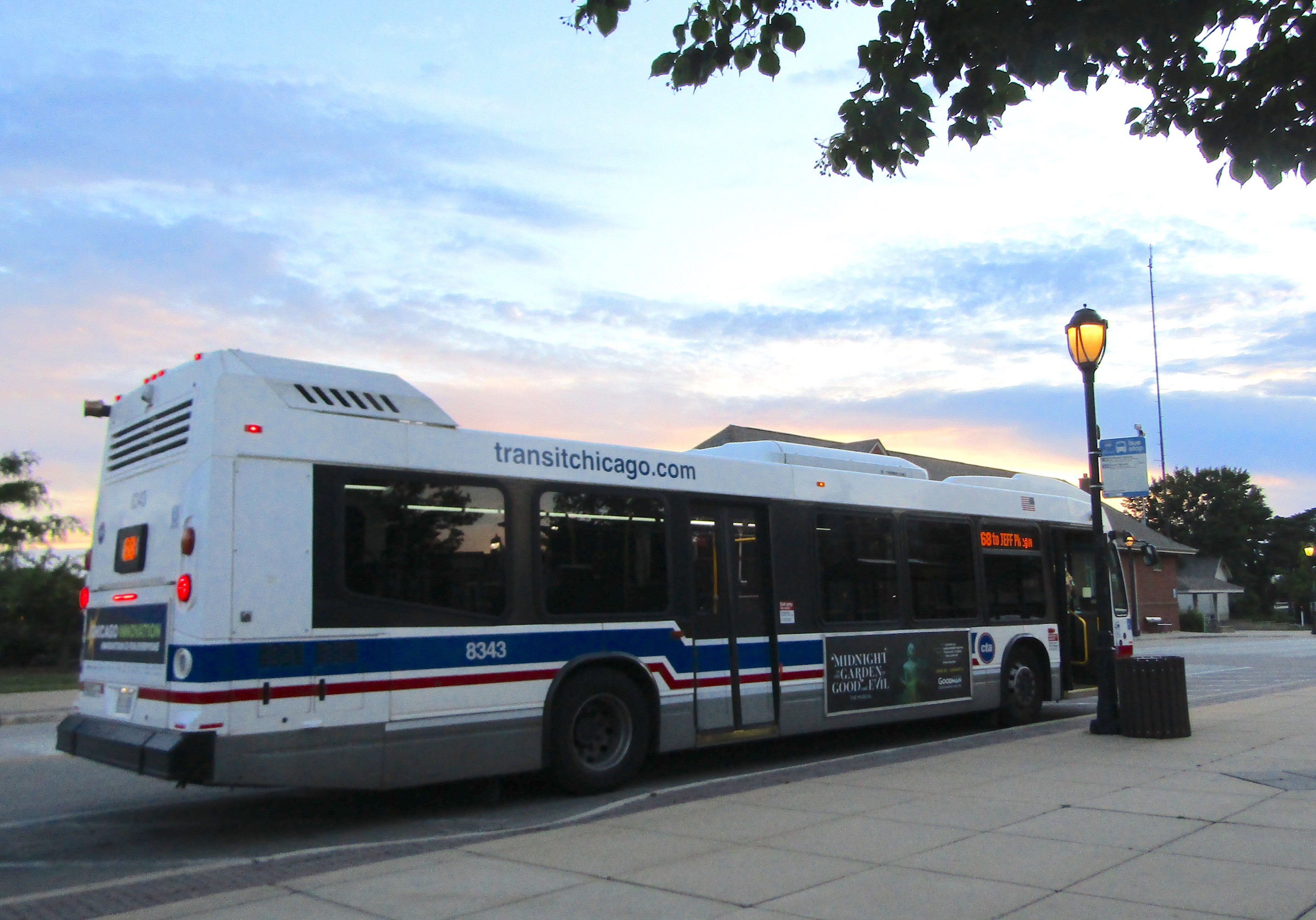
CTA ridership is recovering, but not nearly fast enough to avert the looming $730 million regional transit fiscal cliff. So the transit agency is making a four-pronged effort to regain past riders and attract new ones.

In a report presented during the CTA board's nearly 3-hour June 25 meeting, Chief Innovation Officer Molly Poppe said the transit agency will work to grow off-peak and weekend ridership; expand and extend existing service; improve customer service; and increase advertising. Not surprisingly, CTA data showed that routes with service improvements saw ridership come back faster.
Moreover, Poppe acknowledged that negative experiences can drive riders away. She admitted that the CTA needs can get better at communicating with riders, and making them feel like their complaints get results.
Service improvements
During the presentation, Poppe said there are positive signs for CTA ridership. Before the pandemic, the system routinely had days when total ridership exceeded 1 million. While the agency still has a ways to go to reach that level again, she said that with 25 "million-ride days" so far this year, it's already close to exceeding the 2023 total of 27 days.

"I would note that a lot of those days where we saw that ridership didn’t have to do with special events," Poppe said. "It is everyday riders, it is folks who are using us not only to get to work, but they’re using us for their families, their children and doing other leisure activities."
While the chart shared during the presentation didn’t break down the numbers by day, May 2024 saw 12 days with a million rides taken. The Memorial Day weekend likely accounted for some of the high ridership, but it doesn’t explain why there were several other busy days.
Poppe also said the CTA is conscious of the lapsed rider problem. She explained that 97 percent of pre-pandemic Ventra accounts are still active, but the customers aren't riding as much as before. "As we think about how do we try to regain riders, how do we get customers to ride more, we really want to increase the number of rides those active accounts are taking."

As more Chicagoland residents work from home transit during the post-COVID-19 era, the transit agencies have been talking about moving away from their old rush hour commuter-centric visions. Poppe's presentation showed that the CTA is no exception.
Before the pandemic, she said, the agency's efforts to grow ridership were rail-focused. "It was very much downtown commuter-focused, peak service focused," Poppe said. But as COVID eased, "We started to think about, what are those off-peak riders, what are the bus versus rail riders? As we all know, five days a week in the office is not going to happen anymore."
Generally, the CTA is looking to tailor different approaches that fit different demographics. For example, Poppe said that since the pandemic, the system "has seen precipitous growth in those who have been buying and utilizing our one-day pass." The agency hopes that initiatives such as the Regional Day Pass would make that category grow.
Poppe said all Chicago area systems saw weekend ridership recover faster than weekday ridership. "Poppe said that "One area where we see a lot of bang for our buck is our bus service. We really see our bus service as key to continuing to regain riders." This is especially true on weekends, when the buses have been seeing 90 percent of their pre-pandemic ridership.
"That’s a good indicator to us as we start looking forward to 2025 – how do we want to encourage weekend ridership?" Poppe said. “Is there a space for more service, and how do we continue to capitalize on those riders who are riding on weekends?"

The other major ridership rebuilding strategy is to improve bus service, whether it’s by increasing service frequencies, or extending the routes. Poppe said CTA data showed that between May 2023 and May 2024, bus lines that didn’t get service improvements saw a 14 percent ridership increase on average. However, the ones that did get upgrades enjoyed a 21 percent increase during the same period. "We've seen noticeable improvements already in our ridership when we’ve been adding service. We know that frequency can help drive ridership, and the data has borne it out."
She mentioned the recently announced extension of the 9 Ashland route one mile north to Lawrence Avenue as an example of the kind of route improvement that be considered to help boost bus use.
Communications and marketing
Poppe acknowledged that a major barrier to attracting and retaining riders is ridership experience. "You have one bad experience on CTA, that’s going to color ten great experiences that you have."
As part of that, the CTA is adding QR codes on buses and trains that take riders to a short survey that lets them rate their ride. The agency also set up a chatbot to let riders report accidents. In addition, staff are looking into better ways to keep riders informed about service disruptions. "Maybe we can't stop the reroute, maybe we can’t stop the description, but at least we can communicate with you better," Poppe said.
Marketing is another major component. Poppe said the CTA is looking to get riders who take the CTA for work commutes to use the system for leisure activities. She pointed to the Connecting Chicago advertising campaign, which highlights how riders can take the 'L' to stadiums, entertainment venues, and other destinations.

The transit agency is also investing in advertising the system to visitors flying into O’Hare and Midway airports. And it's sending out mailers to people moving to the city. "We’re trying to get people early in the process, as they’re moving to Chicago," Poppe said. "We hit them right away with 'CTA is the best way to get around town.'" She emphasized that the advertising efforts are being tweaked depending what works and what doesn’t – something that’s easier to do with digital ads.
CTA board member Roberto Requejo asked whether the agency is looking at data from the South and West sides to better address "issues around safety, issues happening on the West and South sides that may not be happening" downtown and on the North Side. Chicago's communities of color and lower-income neighborhoods faced transit disparities even before the pandemic.
Cara Bader, the CTA’s vice-president of strategy and innovation, responded that the agency hasn’t traditionally looked at riders’ racial and income demographic data. She said staffers can draw certain conclusions based on geography, but the CTA is currently looking into getting more granular data, especially when it comes to income.
Requejo also asked whether the agency tracks responses to rider complaints to make sure they’re actually addressed. Poppe responded that the CTA is aware that having the riders feel like they are listened to, and their feedback gets results, would go a long way towards building goodwill. "It is the area of growth for us and something we are looking to improve upon."
Pastor Michael Eaddy, whom Chicago Mayor Brandon Johnson recently appointed to the board, said he was "very happy to hear that customer service and the better experience is a focus, because that’s what it has to be. As long as we can keep the target and a central focus, I think we're moving in the right direction."

Did you appreciate this post? Please consider making a tax-deductible donation, to help keep Streetsblog Chicago's sustainable transportation news and advocacy articles paywall-free.




